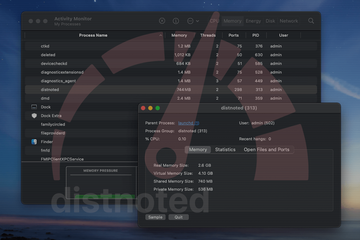With many users having a hard time tackling the distnoted Mac memory and CPU overuse issue, here are some actionable insights into this nuisance.
What is the distnoted Mac process?
In the design of any electronic system, seamless interoperability between its components plays a crucial role. It is a prerequisite for smooth performance and hassle-free user experience. Conceptually, it lays the groundwork for coherence that’s necessary to live up to the very notion of a system in a broad sense, where things work together and form a whole. Apple’s macOS leverages a set of proprietary instruments to glue up different processes in a frictionless way. The daemon called “distnoted” is one of them. Its name stands for “Distributed Notification Services”. Contrary to some interpretations you’ll find online, the upshot of its functioning has nothing to do with notifications that a user can see and interact with. Instead, it runs in the background and syncs certain workflows so that they operate in concert. In the official developer documentation, distnoted isn’t labeled as a critical service, which means that stopping it won’t cause the operating system to malfunction. Yet, it should be kept active as long as no anomalies occur along the way and throw a spanner in the works. Sadly, this isn’t always the case.
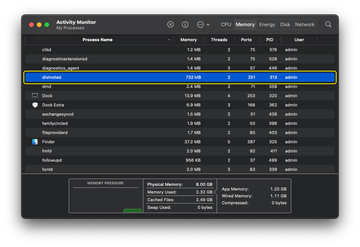
What makes distnoted go haywire?
The most encountered problem with this process is it may start gobbling up an insanely big amount of memory and CPU on a Mac. When this condition kicks in, the resource usage skyrockets above the commonsensical 100% threshold, according to Activity Monitor stats. This, predictably, has a noticeable footprint in terms of system productivity and fan speed. As a result, you get a sluggish and super-noisy computer for ostensibly no apparent reason. This drag has been manifesting itself for years, with the first mentions dating back to the release of OS X El Capitan 10.11.4. The issue was massive in macOS Catalina and continues to be a headache for those using the latest builds, Monterey and Ventura. Obviously, all these versions are susceptible to a periodic bug in their interprocess communication.
The distnoted high memory virus may re-infect your Mac multiple times unless you delete all of its fragments, including hidden ones. Therefore, it is recommended to download Combo Cleaner and scan your system for these stubborn files. This way, you may reduce the cleanup time from hours to minutes.
Download Now Learn how Combo Cleaner works. If the utility spots malicious code, you will need to buy a license to get rid of it.At the time of writing, there is still no explanation that fits every scenario in which the distnoted daemon consumes most RAM and CPU capacity. The only common denominator is that the abnormality occurs when another application crashes repeatedly or attempts to gain a foothold in system areas it isn’t authorized to access. In these cases, distnoted gets stuck in a loop when trying to process the system message for the buggy or misbehaving program, to no avail. Such a predicament can be identified by multiple instances of the same daemon (dozens of them) running concurrently under Activity Monitor’s CPU or Memory tabs. Many people have reportedly stumbled upon the issue when using third-party cloud backup and syncing services such as OneDrive. Also, the distnoted high memory issue might co-occur with the activity of a system service named Locum, which is used by macOS to delete or access data and applications protected by administrator privileges.
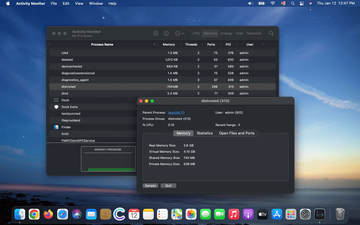
There is one more possibility that goes beyond the secure, purely technical zone. A fairly widespread technique employed by Mac malware makers is to inject malicious code into legitimate system workflows. Another mechanism in these folks’ handbooks is to create sketchy processes that impersonate normal ones. In either case, the objective is to confuse macOS protections so that harmful code flies undetected. If a strain of malware manages to poison distnoted or portrays itself as this daemon, the system’s XProtect feature and notarization controls provided by Gatekeeper might overlook the infection. Meanwhile, as the pest tries to access restricted environments within macOS, distnoted will get out of hand and use a large portion of the memory and CPU power. This theory isn’t very likely to be observed in the wild, but it isn’t as far-fetched as it may appear and should be taken seriously. Some past outbreaks of Mac threats have led to similar resource overuse problems. The long-standing WindowServer high CPU bug is an example of messy activity like that.
How to fix the distnoted Mac memory issue
As previously mentioned, the good news is that the distnoted process can be safely stopped without any significant consequences for the stability of a Mac. This will address the problem for a while, but the adverse condition will probably resurface down the line. One way or another, it’s worth a shot. Open the Activity Monitor, find distnoted in the list of running processes, and click the “Stop” button at the top (the one with the X sign). In a dialog that will pop up, click “Force Quit”. If there are multiple strings for this daemon, go ahead and terminate each one. It’s recommended to follow this procedure for the “Memory” tab as well. In the event that the story repeats, you’ll have to try other methods.
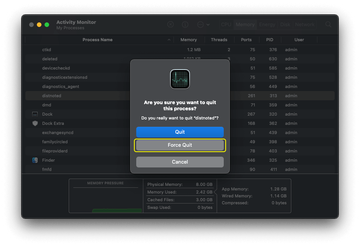
Since distnoted tends to get particularly busy maintaining proper deep-level communications during various data syncing routines, paying close attention to the active cloud backup services is a good idea. If OneDrive is installed and running on your Mac, chances are that its Finder integration tool is the culprit. If it isn’t working right, disabling and re-enabling it could help. To do this, open System Preferences, click “Extensions”, select “Finder Extensions” in the sidebar, and uncheck “OneDrive Finder Integration”. Wait for a few minutes and re-enable it. Reboot your Mac and see if the problem persists.
A Mac factory reset is a potential fix, too. It allows you to start fresh with the operating system, declutter its critical components and processes, and even remove viruses if they are on board. The flip side of this approach is that it takes time and causes a great deal of inconveniences, such as the need to customize everything as well as install and configure third-party applications. Before taking this radical measure, there is one more thing you can try if neither terminating the distnoted process nor experimenting with file syncing apps does the trick. Checking your computer for malware won’t go amiss – for the reasons described above. The steps below will walk you through the procedure. In case no malware is found, reverting to factory settings is perhaps the last resort option.
Distnoted high memory and CPU virus manual removal from Mac
The steps listed below will walk you through the removal of this malicious application. Be sure to follow the instructions in the specified order.
Expand the Go menu in your Mac’s Finder bar and select Utilities as shown below.
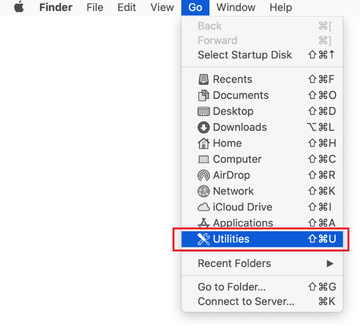
Locate the Activity Monitor icon on the Utilities screen and double-click on it.
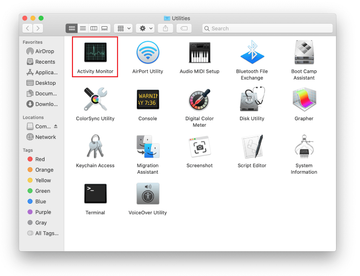
In the Activity Monitor app, look for a process that appears suspicious. To narrow down your search, focus on unfamiliar resource-intensive entries on the list. Keep in mind that its name isn’t necessarily related to the way the threat is manifesting itself, so you’ll need to trust your own judgement. If you pinpoint the culprit, select it and click on the Stop icon in the upper left-hand corner of the screen.
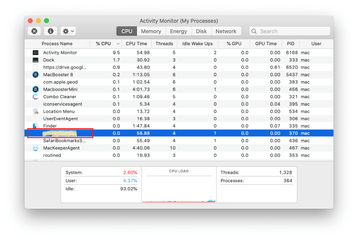
When a follow-up dialog pops up asking if you are sure you want to quit the troublemaking process, select the Force Quit option.
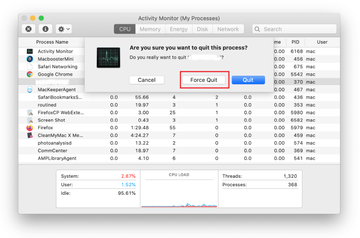
Click on the Go menu icon in the Finder again and select Go to Folder. You can as well use the Command-Shift-G keyboard shortcut.
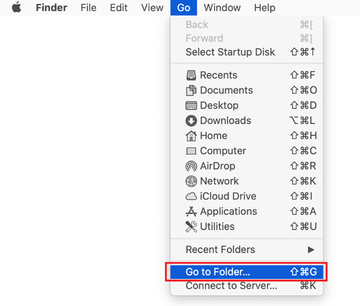
Type /Library/LaunchAgents in the folder search dialog and click on the Go button.

Examine the contents of the LaunchAgents folder for dubious-looking items. Be advised that the names of files spawned by malware may give no clear clues that they are malicious, so you should look for recently added entities that appear to deviate from the norm.
As an illustration, here are several examples of LaunchAgents related to mainstream Mac infections: com.updater.mcy.plist, com.avickUpd.plist, and com.msp.agent.plist. If you spot files that don’t belong on the list, go ahead and drag them to the Trash.
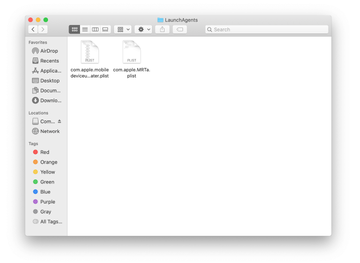
Use the Go to Folder lookup feature again to navigate to the folder named ~/Library/Application Support (note the tilde symbol prepended to the path).
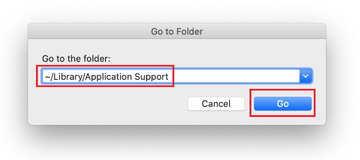
When the Application Support directory is opened, identify recently generated suspicious folders in it and send them to the Trash. A quick tip is to look for items whose names have nothing to do with Apple products or apps you knowingly installed. A few examples of known-malicious folder names are ProgressSite and IdeaShared.
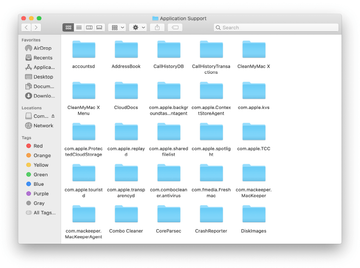
Enter ~/Library/LaunchAgents string (don’t forget to include the tilde character) in the Go to Folder search area.
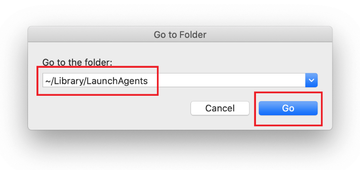
The system will display LaunchAgents residing in the current user’s Home directory. Look for dodgy items related to the rogue distnoted process (see logic highlighted in subsections above) and drag the suspects to the Trash.
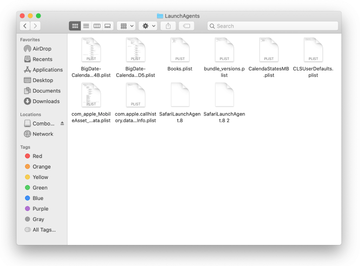
Type /Library/LaunchDaemons in the Go to Folder search field.

In the LaunchDaemons path, try to pinpoint the files the malware is using for persistence. Several examples of such items cropped by Mac infections are com.apple.sysmond.plist, com.startup.plist, and com.ExpertModuleSearchDaemon.plist. Delete the sketchy files immediately.
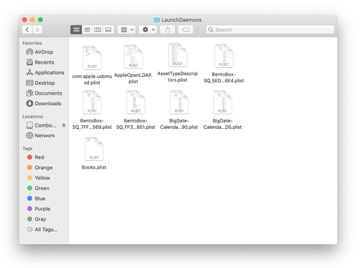
Click on the Go menu icon in your Mac’s Finder and select Applications on the list.
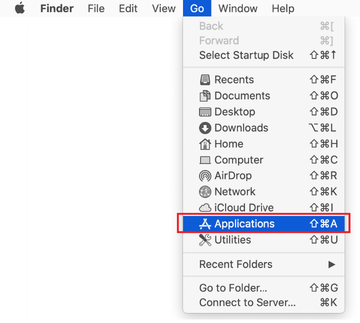
Find the entry for an app that clearly doesn’t belong there and move it to the Trash. If this action requires your admin password for confirmation, go ahead and enter it.
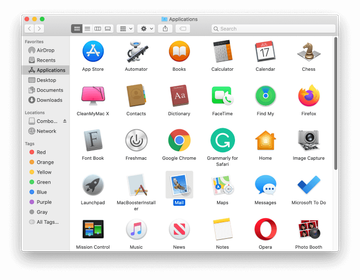
Expand the Apple menu and select System Preferences.
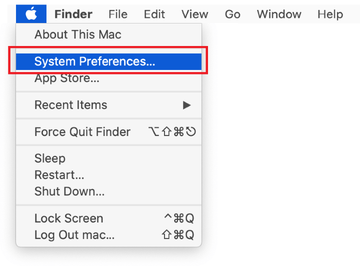
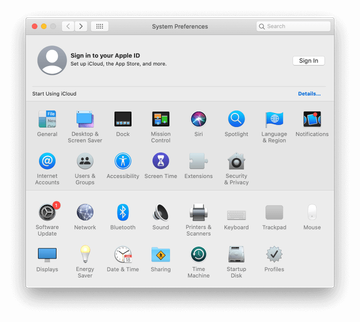
Proceed to Users & Groups and click on the Login Items tab.
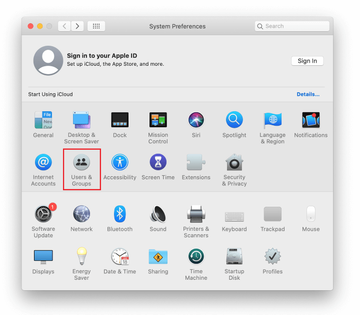
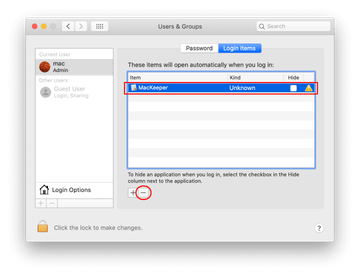
Now select Profiles under System Preferences. Look for a malicious item in the left-hand sidebar. Several examples of configuration profiles created by Mac adware include TechSignalSearch, MainSearchPlatform, AdminPrefs, and Safari Settings. Select the offending entity and click on the minus sign at the bottom to eliminate it.
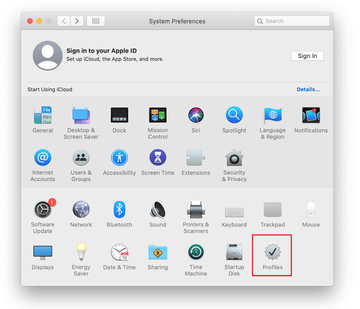
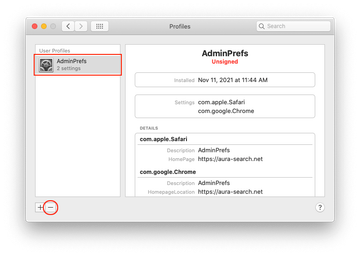
Get rid of distnoted related malware in web browser on Mac
To begin with, the web browser settings taken over by the distnoted malware should be restored to their default values. Although this will clear most of your customizations, web surfing history, and all temporary data stored by websites, the malicious interference should be terminated likewise. The overview of the steps for completing this procedure is as follows:
- Fix the distnoted problem in Safari
- Open the browser and go to Safari menu. Select Preferences in the drop-down list.
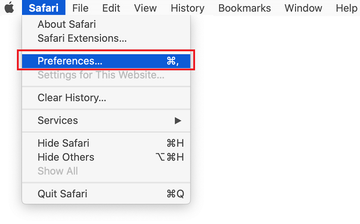
- Once the Preferences screen appears, click on the Advanced tab and enable the option saying “Show Develop menu in menu bar”.
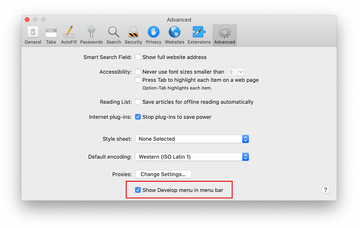
- Now that the Develop entry has been added to the Safari menu, expand it and click on Empty Caches.
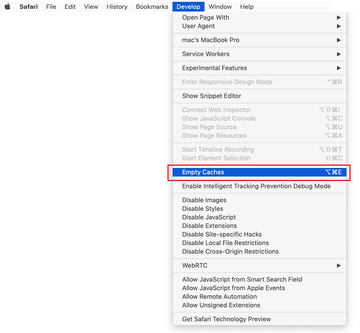
- Now select History in the Safari menu and click on Clear History in the drop-down list.
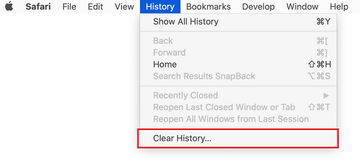
- Safari will display a dialog asking you to specify the period of time this action will apply to. Select all history to ensure a maximum effect. Click on the Clear History button to confirm and exit.
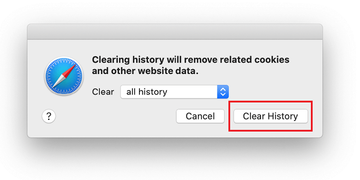
- Go back to the Safari Preferences and hit the Privacy tab at the top. Find the option that says Manage Website Data and click on it.

- The browser will display a follow-up screen listing the websites that have stored data about your Internet activities. This dialog additionally includes a brief description of what the removal does: you may be logged out of some services and encounter other changes of website behavior after the procedure. If you’re okay with that, go ahead and click on the Remove All button.
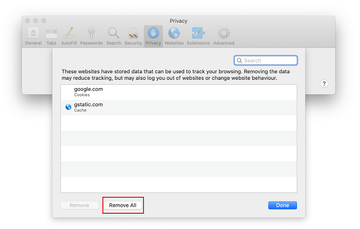
- Restart Safari
- Open the browser and go to Safari menu. Select Preferences in the drop-down list.
- Get rid of distnoted bug in Google Chrome
- Open Chrome, click the Customize and control Google Chrome (⁝) icon in the top right-hand part of the window, and select Settings in the drop-down
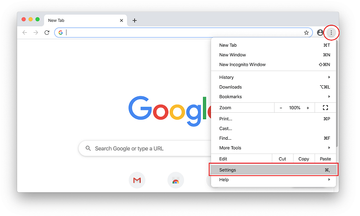
- When on the Settings pane, select Advanced
- Scroll down to the Reset settings section.
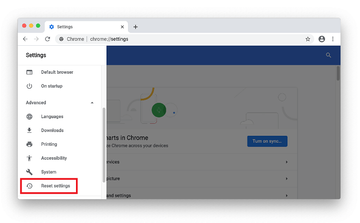
- Confirm the Chrome reset on a dialog that will pop up. When the procedure is completed, relaunch the browser and check it for malware activity.
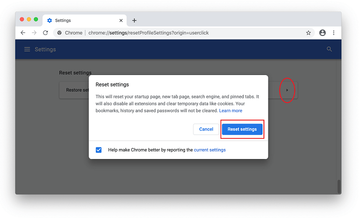
- Open Chrome, click the Customize and control Google Chrome (⁝) icon in the top right-hand part of the window, and select Settings in the drop-down
- Remove distnoted malware in Mozilla Firefox
- Open Firefox and go to Help – Troubleshooting Information (or type about:support in the URL bar and press Enter).
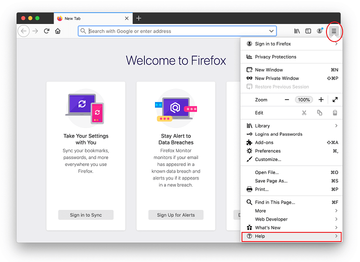
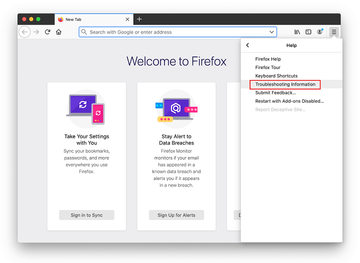
- When on the Troubleshooting Information screen, click on the Refresh Firefox button.
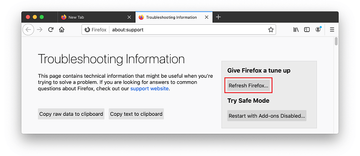
- Confirm the intended changes and restart Firefox.
- Open Firefox and go to Help – Troubleshooting Information (or type about:support in the URL bar and press Enter).
Fix distnoted Mac memory issue using Combo Cleaner removal tool
The Mac maintenance and security app called Combo Cleaner is a one-stop tool to detect and remove distnoted high memory virus. This technique has substantial benefits over manual cleanup, because the utility gets hourly virus definition updates and can accurately spot even the newest Mac infections.
Furthermore, the automatic solution will find the core files of the malware deep down the system structure, which might otherwise be a challenge to locate. Here’s a walkthrough to sort out the distnoted high memory issue using Combo Cleaner:
Download Combo Cleaner installer. When done, double-click the combocleaner.dmg file and follow the prompts to install the tool onto your Mac.
By downloading any applications recommended on this website you agree to our Terms and Conditions and Privacy Policy. The free scanner checks whether your Mac is infected. To get rid of malware, you need to purchase the Premium version of Combo Cleaner.
Open the app from your Launchpad and let it run an update of the malware signature database to make sure it can identify the latest threats.
Click the Start Combo Scan button to check your Mac for malicious activity as well as performance issues.

Examine the scan results. If the report says “No Threats”, then you are on the right track with the manual cleaning and can safely proceed to tidy up the web browser that may continue to act up due to the after-effects of the malware attack (see instructions above).
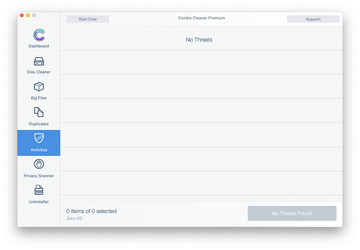
In case Combo Cleaner has detected malicious code, click the Remove Selected Items button and have the utility remove distnoted high memory threat along with any other viruses, PUPs (potentially unwanted programs), or junk files that don’t belong on your Mac.
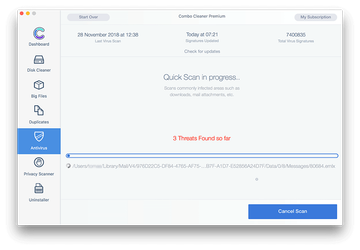
Once you have made doubly sure that the malicious app is uninstalled, the browser-level troubleshooting might still be on your to-do list. If your preferred browser is affected, resort to the previous section of this tutorial to revert to hassle-free web surfing.
